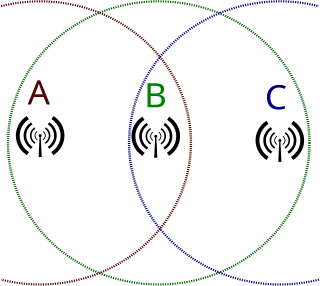Related Research Articles

A wireless LAN (WLAN) is a wireless computer network that links two or more devices using wireless communication to form a local area network (LAN) within a limited area such as a home, school, computer laboratory, campus, or office building. This gives users the ability to move around within the area and remain connected to the network. Through a gateway, a WLAN can also provide a connection to the wider Internet.
100BaseVG is a 100 Mbit/s Ethernet standard specified to run over four pairs of category 3 cable. It is also called 100VG-AnyLAN because it was defined to carry both Ethernet and Token Ring frame types.

Carrier-sense multiple access with collision avoidance (CSMA/CA) in computer networking, is a network multiple access method in which carrier sensing is used, but nodes attempt to avoid collisions by beginning transmission only after the channel is sensed to be "idle". When they do transmit, nodes transmit their packet data in its entirety.
Carrier-sense multiple access with collision detection (CSMA/CD) is a media access control (MAC) method used most notably in early Ethernet technology for local area networking. It uses carrier-sensing to defer transmissions until no other stations are transmitting. This is used in combination with collision detection in which a transmitting station detects collisions by sensing transmissions from other stations while it is transmitting a frame. When this collision condition is detected, the station stops transmitting that frame, transmits a jam signal, and then waits for a random time interval before trying to resend the frame.
Carrier-sense multiple access (CSMA) is a media access control (MAC) protocol in which a node verifies the absence of other traffic before transmitting on a shared transmission medium, such as an electrical bus or a band of the electromagnetic spectrum.
In telecommunications and computer networks, a channel access method or multiple access method allows more than two terminals connected to the same transmission medium to transmit over it and to share its capacity. Examples of shared physical media are wireless networks, bus networks, ring networks and point-to-point links operating in half-duplex mode.
ALOHAnet, also known as the ALOHA System, or simply ALOHA, was a pioneering computer networking system developed at the University of Hawaii. ALOHAnet became operational in June 1971, providing the first public demonstration of a wireless packet data network. ALOHA originally stood for Additive Links On-line Hawaii Area.
A collision domain is a network segment connected by a shared medium or through repeaters where simultaneous data transmissions collide with one another. The collision domain applies particularly in wireless networks, but also affected early versions of Ethernet. A network collision occurs when more than one device attempts to send a packet on a network segment at the same time. Members of a collision domain may be involved in collisions with one another. Devices outside the collision domain do not have collisions with those inside.
10BROAD36 is an obsolete computer network standard in the Ethernet family. It was developed during the 1980s and specified in IEEE 802.3b-1985.
A network segment is a portion of a computer network. The nature and extent of a segment depends on the nature of the network and the device or devices used to interconnect end stations.
Distributed coordination function (DCF) is the fundamental medium access control (MAC) technique of the IEEE 802.11-based WLAN standard. DCF employs a carrier-sense multiple access with collision avoidance (CSMA/CA) with binary exponential backoff algorithm.

In wireless networking, the hidden node problem or hidden terminal problem occurs when a node can communicate with a wireless access point (AP), but cannot directly communicate with other nodes that are communicating with that AP. This leads to difficulties in medium access control sublayer since multiple nodes can send data packets to the AP simultaneously, which creates interference at the AP resulting in no packet getting through.

A bus network is a network topology in which nodes are directly connected to a common half-duplex link called a bus.
RTS/CTS is the optional mechanism used by the 802.11 wireless networking protocol to reduce frame collisions introduced by the hidden node problem. Originally the protocol fixed the exposed node problem as well, but modern RTS/CTS includes ACKs and does not solve the exposed node problem.
Exponential backoff is an algorithm that uses feedback to multiplicatively decrease the rate of some process, in order to gradually find an acceptable rate. These algorithms find usage in a wide range of systems and processes, with radio networks and computer networks being particularly notable.

A Medium Attachment Unit (MAU) is a transceiver which converts signals on an Ethernet cable to and from Attachment Unit Interface (AUI) signals.
In computer networking, carrier-sense multiple access with collision avoidance and resolution using priorities (CSMA/CARP) is a channel access method. CSMA/CARP is similar in nature to the carrier-sense multiple access with collision detection (CSMA/CD) channel access method used in Ethernet networks, but CSMA/CARP provides no detection of network collisions. Instead of detecting network collisions, CSMA/CARP attempts to avoid collisions by using a system of transmission priorities.
In statistical time division multiplexing, contention is a media access method that is used to share a broadcast medium. In contention, any computer in the network can transmit data at any time.
The 5-4-3 rule, also referred to as the IEEE way, is a design guideline for Ethernet computer networks covering the number of repeaters and segments on shared-access Ethernet backbones in a tree topology. It means that in a collision domain there should be at most 5 segments tied together with 4 repeaters, with up to 3 mixing segments. Link segments can be 10BASE-T, 10BASE-FL or 10BASE-FB. This rule is also designated the 5-4-3-2-1 rule with there being two link segments and one collision domain.

Mobile Slotted Aloha (MS-Aloha) is a wireless network protocol proposed for applications such as vehicle networks.
References
- ↑ Source: from Federal Standard 1037C and from MIL-STD-188